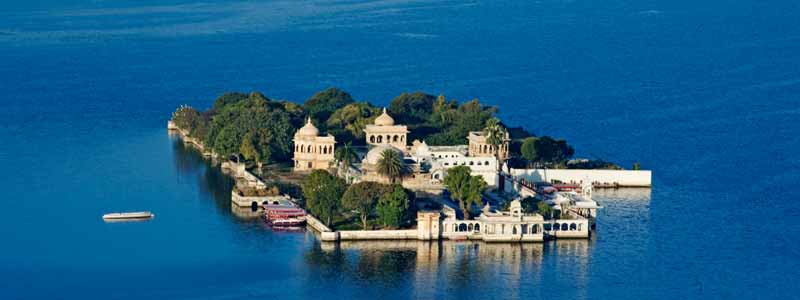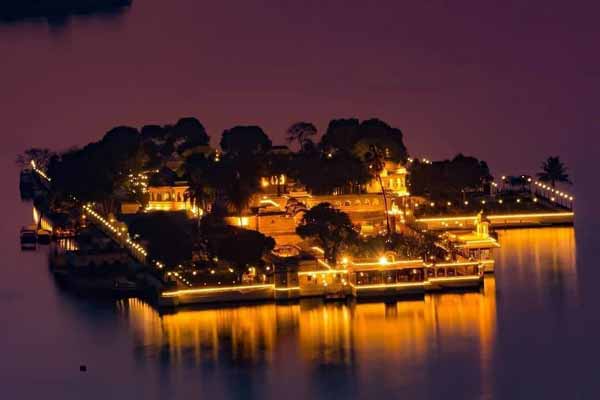Jag Mandir Udaipur is one of the most famous places in the city of Udaipur, Rajasthan. Udaipur is one of the most beautiful cities in the whole of India. This city is one of the important historical and tourism destinations of the Indian state Rajasthan. Due to the presence of many lakes in Udaipur, Udaipur is more commonly known as the city of lakes. The Lake Pichola is one of the largest lakes in Udaipur and also one of the most famous tourism destinations in these parts of the state. There are many water palaces on the Pichola lake and of them Jag Mandir Palace is located on one of the islands in the lake.
The Jag Mandir is also known as the Lake Garden Palace because it is a beautifully decorated pleasure place built by the kings of Mewar during the 16th and 17th centuries into the Common Era. It has a long history of construction as it was completed by three generations of Maharanas of the Sisodia Rajput Clan. It was started during the reign of Maharana Amar Sing in 1551 and continued through the reign of Karan Singh and was finally completed during the regime of Maharana Jagat Singh I. It was after the name of the latter that the palace was named Jag Mandir Udaipur.
This summer palace was constructed as a guest house and a recreational centre. It is the same place where Shah Jahan took refuge during his ascension rebellion. It is believed that Jag Mandir Udaipur inspired him to build the world famous Taj Mahal.
The Jag Mandir palace is an architectural marvel that is filled with grand buildings, fountains, beautiful courtyards, landscape gardens, open air theatres and of course the breathtaking lake view. With Aravalli in the back drop, Udaipur Jag Mandir is one of the most attractive tourist spots in the whole Rajasthan. It’s also very easy to reach and water boating is the best tourist activity here.

History of Jag Mandir
Jagmandir has an interesting history associated with the Mughal emperor Shahjahan, earlier known as Prince Khurram. In the year 1623, Khurram rebelled against his father Jahangir as he wanted to occupy the throne. Fearing for his safety, Khurram sought refuge in Mewar kingdom of Udaipur Tour Packages which was under the rule of Maharana Karan Singh.
Maharana Karan Singh offered refuge to Khurram as he was born to a Rajput lady. Khurram along with his wife and two sons were initially kept in City Palace. Later they were moved to Gul Mahal in the partially completed Jag Mandir as it was safer due to its location amidst the lake.
The domed pavilion, Gul Mahal remained as a refugee camp for Khurram for many years. It was later enlarged by Maharana Karan Singh’s son Jagat Singh into a magnificent palace and named as Jag Mandir palace. The palace left a huge impact on Khurram who later became Emperor Shah Jahan and went on built the marvellous wonder Taj Mahal.
Maharana Jagat Singh added further new structures to the Jag Mandir Udaipur complex including Gul Mahal. He was responsible for completing the construction of Jagmandir Isla in the 17th century. In his honour, the palace was named after him.
Jagmandir acted as a refuge palace in one more occasion which was during the revolt of 1857. During the war, Maharana Swaroop Singh offered shelter to a number of European families in this palace.
Architecture
The yellow sandstone structure of Jag Mandir Udaipur comprises numerous structures that are built over its three floors.
Some of its very prominent structures are detailed as below:
Gul Mahal
Gul Mahal was the very first structure of the palace, which was built under the rule of Maharana Amar Singh, in the year 1551. During the early days, Gul Mahal just stood as a yellow sandstone palace which has an impression of a crown at the top. It is due to the imposing dome structure with the Islam crescent placed on the Mahal.
The architecture of Gul Mahal is divided into three circular domed chambers, all of which has a common entry, from a columned hall. The main face of the structure flaunts twin marble Chatris or canopies. Marble decoration in the design is teamed up with precious stones such as onyx, jasper, rubies, jade and cornelian.
It resembles a lot to the decoration of Itamad-ud-Daulah; a Mughal creation, at Agra city. The Mahal from the outside is surrounded by circular apartments of white and black marble, which adorns exquisite murals and paintings.
Jag Mandir
Gul Mahal, when enlarged by the succeeding ruler, came to be known as Jag Mandir. Sporting a fascinating blend of Mughal and Rajput style of architecture, Jag Mandir Udaipur features reception halls, internal courts and residential suites.
For the royal ladies, an adjoining palace known as ‘Zenana’, is still maintained. Whereas, the palace of the erstwhile crown prince can be located at the western end of Jag Mandir Udaipur.
Entry Pavillion
Designing of the Jag Mandir Palace have been exquisite at all grounds. Not only in context of the designing of the hall and other interiors, but the entry point of the palace as well. Just like the other structures, the entry pavilion stands apart in terms of decoration.
Best time to visit Udaipur
Udaipur Attractions, being a part of the desert land of Rajasthan is prone to a hot season in the summers. Owing to which, one must consider visiting this city between the months of September and March.
How to Reach
The Lake Garden Palace can be reached through a 30-minute or 1 hour boat ride from the Bansi Ghat jetty. There are private boats and cruise rides available.
By Air: The city of Udaipur has a well-operational airport, known as the Maharana Pratap airport, located at a distance of 20 km from the center of the city. The airport has a good connectivity with major Indian cities like Delhi, Kolkata, Jaipur and Mumbai.
By Rail: Udaipur is also connected to important cities of India by the medium of railways. Trains from and to Jaipur, Kolkata, Indore, Delhi, Mumbai and Kota are operational at a regular basis from the Jag Mandir Udaipur railway station.
By Road: A well-maintained network of road connects Udaipur from various nearby cities. Self-drive or bus journeys are reliable options to make it to the city.
